Influence of Ventilation in Residential Structures: Tactical Implications Part 2
Saturday, June 18th, 2011Is making entry with a hoseline for fire attack, ventilation? Is entering through a doorway when conducting search, ventilation? While many firefighters do not think about ventilation when performing these basic fireground tasks, the answer is a resounding yes!
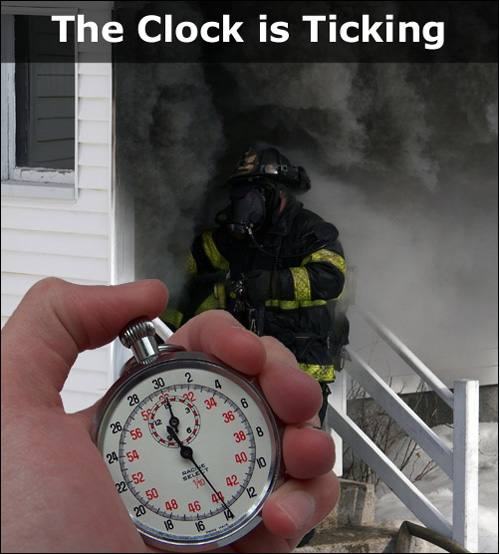
Making Entry is Ventilation
While the Essentials of Firefighting (IFSTA, 2008) defines ventilation as “the systematic removal of heated air, smoke, and fire gases from a burning building and replacing them with cooler air” [emphasis added] (p. 541), the main focus of most ventilation training is on the exhaust opening. In discussing compartment fire development, the 6th Edition of Essentials (IFSTA, 2008) includes a discussion of the concept of fuel and ventilation controlled burning regimes. In addition, the section of the text addressing the positive effects of ventilation such as reducing potential for flashover and backdraft, Essentials (IFSTA, 2008) cautions that increasing ventilation to ventilation limited fires may result in rapid fire progression. However, these concepts were not included in earlier additions and the connection between openings made for the purpose of ventilation and openings made for other reasons is often overlooked.
Ventilation versus Tactical Ventilation
Despite the definitions given in fire service text that describe ventilation in terms of actions taken by firefighters, ventilation is simply the exchange of the atmosphere inside a building with that which is outside. Normal air exchange between the interior and exterior of a building is expressed as the number of complete air exchanges (by volume) per hour and varies depending on the purpose and function of the space. In residential structures, the air in the building is completely exchanged approximately four times per hour. In commercial and industrial buildings this rate may be significantly higher, depending on use. When firefighters arrive to find smoke issuing from a building, ventilation is occurring and when firefighters open a door to make entry, the ventilation profile changes as ventilation has been increased. Remember:
- If smoke exits the opening (air is entering somewhere else) ventilation is occurring.
- If air enters the opening (smoke is exiting somewhere else), ventilation is occurring.
- If smoke exits and air enters the opening ventilation is occurring.
The entry point is a ventilation opening and if the fire is ventilation controlled, any ventilation opening will increase heat release rate (HRR)!
Ventilation Controlled Fires
As discussed in Influence of Ventilation in Residential Structures: Tactical Implications Part 1 [LINK], compartment fires that have progressed beyond the incipient stage are likely to be ventilation controlled when the fire department arrives. Firefighters and fire officers must recognize the potential for a rapid increase in HRR when additional atmospheric oxygen is provided to ventilation controlled fires. This is particularly important when considering door entry and door control during fire attack, search, and other interior operations. The Underwriters Laboratories (UL) research project Impact of Ventilation on Fire Behavior in Legacy and Contemporary Residential Construction (Kerber, 2011) examined fire behavior in a small, single-story, wood frame house and a larger, two-story, wood frame house (see Figures 1 & 2) Figure 1. Single-Story Legacy Dwelling
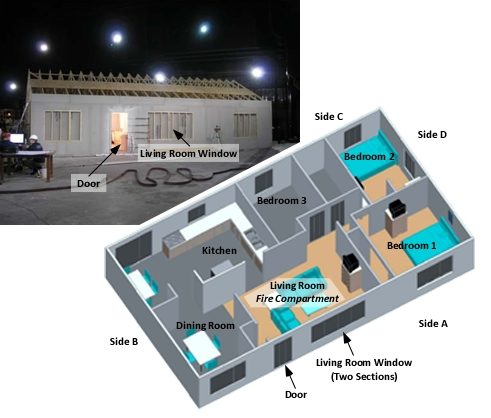
Figure 2. Two-Story Contemporary Dwelling

Each of the fires in these experiments occurred in the living room (one-story house) or family room (two-story house). While the fuel load was essentially the same, the family room had a much greater volume as it had a common cathedral ceiling with an atrium just inside the front door. Experiments one and two examined fire behavior in each of these structures with the front door being opened at the simulated time of arrival of the fire department. Figure 3 illustrates the changes in temperature during UL Experiment 1 (Single Story-Door as Vent Opening) and Experiment 2 (Two-Story-Door as Vent Opening). Figure 3. Living/Family Room Temperature Curves-Door as Ventilation Opening
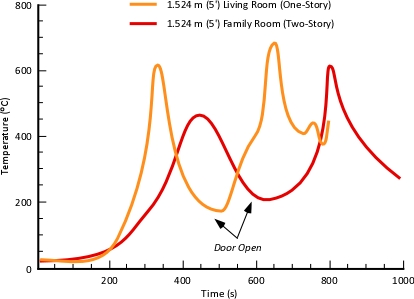
As illustrated in Figure 3, temperature conditions changed dramatically and became untenable shortly after the front door was opened. In the one-story experiment (Experiment 1) temperature:
- Was 180 °C (360 °F) at ventilation (480 s),
- Exceeded the firefighter tenability threshold of 260 °C (500 °F) at 550 s
- Reached 600 °C (1110 °F) at 650 s and transitioned through flashover to a fully developed fire in the living room
In the two-story experiment (Experiment 2) temperature:
- Was 220 °C (430 °F) at ventilation (600 s)
- Exceeded the firefighter tenability threshold of 260 °C (500 °F) at 680 s
- Reached 600 °C (1110 °F) at 780 s and transitioned through flashover to a fully developed fire in the family room
When the door is opened the clock is ticking! HRR will increase and the tenability within the fire compartment and adjacent spaces will quickly deteriorate unless water can be applied to control the fire. Keeping the door closed until ready to make entry delays starting the clock. Closing the door after entry (leaving room for passage of your hoseline) slows fire development and buys valuable time to control the fire environment, locate the fire, and achieve fire control.
Just as in the UL experiments on the influence of ventilation in residential structures, heat release rate will increase and fire conditions can change dramatically when a door is opened for access and entry.
In 2008, two firefighters from the Riverdale Volunteer Fire Department in Prince Georges County Maryland recently were surprised by a flashover in a small, single family dwelling. In the first photo, firefighters from Engine 813 and Truck 807 prepare to make entry. Note that the front door is closed, the glass of the slider and windows are darkened, and smoke can be observed in the lower area of the front porch. Six seconds later it appears that the front door has been opened, flames are visible through the sliding glass door, and the volume of smoke in the area of the porch has increased. However, the smoke is not thick (optically dense). Forty eight seconds later, as the crew from Truck 807 makes entry to perform horizontal ventilation the volume of smoke from the front door increases and thickens (becomes more optically dense).
Figure 4. Ventilation Induced Flashover-Door as a Ventilation Opening
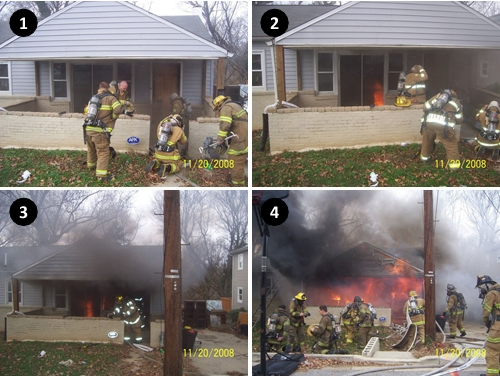
Note: Photos by Probationary Firefighter Tony George, PGFD The crew from Engine 813 experienced a burst hoseline, delaying fire attack. Two minutes after the first photo, and shortly after the crew from Truck 807 made entry, flashover occurred. For additional information on this incident, see Situational Awareness is Critical.
Door Control
The issue of door control presents a similar (and related) paradox as ventilation. Ventilation is performed to improve interior tenability and to support fire control, but when presented with a ventilation controlled fire, increased air supply increases HRR and can result in worsening tenability and potential for extreme fire behavior. Firefighters often chock doors open to provide ease of hoseline deployment and an open egress path, but when the fire is ventilation controlled, this (ventilation) opening starts the clock on increased HRR and rapid fire development. It is useful to consider door control in two phases, door entry procedures and control of the door after entry.
Size-Up: Door entry begins with a focused size-up as you approach the building. Assessment of conditions is not only the incident commander or officer’s job. Each member entering the building should perform a personal size-up and predict likely conditions. When making entry, size-up becomes more closely focused on conditions observed at or near the door and includes an assessment of potential forcible entry requirements as well as B-SAHF (Building-Smoke, Air Track, Heat, and Flame) indicators. If available, a thermal imaging camera (TIC) can be useful, but remember that temperature conditions may be masked by the thermal characteristics of the building. If a thermal imaging camera is not available, application of a small amount of water to the door may indicate temperature and the level of the hot gas layer (water will vaporize on contact with a hot door).
Size-up begins as you exit the apparatus and approach the building, but continues at the door and after you make entry!
At the door, pay close attention to air track and heat (door temperature) indicators as these can provide important clues to conditions immediately inside the building!
Prior to Entry: If the door is open, close it. If it is closed, don’t open it until you are ready. If the door is unlocked, control is generally a simple process (see Nozzle Techniques and Hose Handling: Part 3 for detailed discussion of door entry when the door is unlocked).
If the door is locked and must be forced, this adds an element of complexity to the door entry process. In selecting a forcible entry method, consider that the door must remain intact and on its hinges if you are going to maintain control of the air track at the opening.
This is fairly easy with outward opening doors. Inward opening doors present a greater challenge. A section of webbing or rope can be used to control an inward door by placing a cinch hitch around the door knob (see Figure 5). As the the door is forced, it can be pulled closed. However, if the door was not locked with a deadbolt, it may re-latch when pulled closed. Figure 5. Door Control with Web or Utility Rope
Figure 5. Door Control with Webbing or Utility Rope
<
Alternately, a Halligan or hook may be used to capture the door and pull it substantially closed after it is forced (see Figure 6).
Figure 6. Door Control with a Tool

If B-SAHF (Building, Smoke, Air Track, Heat, & Flame) indicators point to hazardous conditions on the other side of the door, forcible entry must be integrated with good door entry procedure to control potential hazards. After Entry: The most effective way to control the door after entry and provide ease of egress is to have a firefighter remain at the opening to control the door and feed hose to the hose team working inside (see Figure 7).
Figure 7. Door Control After Entry
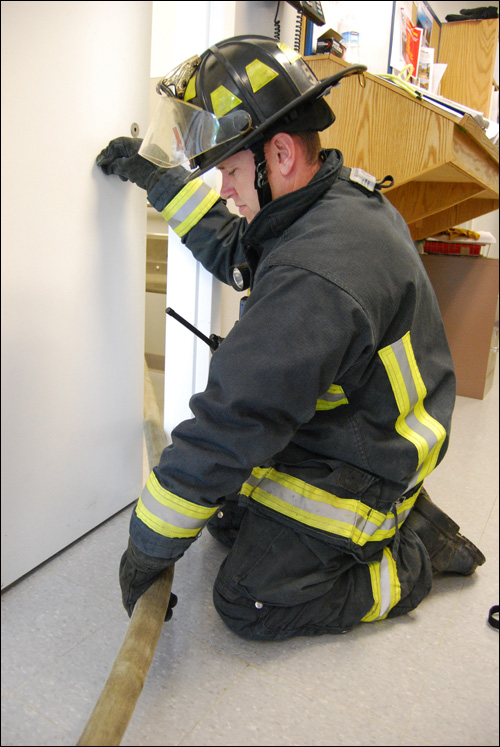
Note: The Firefighter maintaining door control would be wearing complete structural firefighting clothing and breathing apparatus (this is simply an illustration of door control with a hoseline in place)!
Unfortunately, many companies do not have sufficient staff to maintain a nozzle team of two and leave another firefighter at the door. In these cases, it may be possible for the standby firefighters (two-out) to control the door for the crew working inside until additional resources are available.
Nozzle Technique & Hose Handling
Prior posts on nozzle technique and hose handling included a series of drills to develop proficiency in critical skills.
- Hose & Nozzle Technique Drill 1: Basic Nozzle Technique
- Hose & Nozzle Technique Drill 2: Maneuver and Operation
- Hose & Nozzle Technique Drill 3: Adapting to Compartment Configuration
- Hose & Nozzle Technique Drill 4: Door Entry-Inward Opening (Unlocked) & Drill 5: Door Entry-Outward Opening (Unlocked)
- Hose & Nozzle Technique Drill 6: Operating with Limited Visibility
- Hose & Nozzle Technique Drill 7: Indirect Attack
- Hose & Nozzle Technique Drill 8: Tactical Withdrawal (Attack Line)
- Hose & Nozzle Technique Drill 9: Tactical Withdrawal (Attack & Backup Lines)
Review these nine drills and then extend your proficiency by integrating forcible entry with good door entry procedure by maintaining control of the door.
Drill 10-Door Entry-Forcing Inward Opening Doors: Many doors (particularly interior and exterior residential) open inward. In this situation forcible entry, door control, and nozzle operation must bee closely coordinated. Practicing these techniques under a variety of conditions (e.g., wall locations, compartment sizes) is critical to developing proficiency.
Drill 11-Door Entry-Forcing Outward Opening Doors: Commercial (and some interior residential doors) open outward. While less complex, Firefighters must develop skill in integration of forcible entry, door control, and nozzle technique in this situation as well.
Hose Handling and Nozzle Technique Drills 11 & 12 Instructional Plan
In both of these drills, focus on maintaining control of the door during forcible entry and limit air intake by keeping the door as closed as possible while passing the hoseline as it is advanced.
References
Kerber, S. (2011). Impact of ventilation on fire behavior in legacy and contemporary residential construction. Retrieved January 20, 2011 http://www.ul.com/global/documents/offerings/industries/buildingmaterials/fireservice/ventilation/DHS%202008%20Grant%20Report%20Final.pdf
International Fire Service Training Association (IFSTA). (2008) Essentials of firefighting (6th ed.). Stillwater, OK: Fire Protection Publications.


